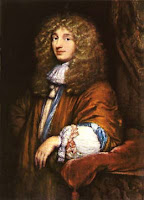Christiaan Huygens & Titan
Today in 1655, Christiaan Huygens (1629-95), the prominent Dutch scientist, discovered Titan, Saturn's largest moon. He determined its period of revolution but did not name the satellite. The moon wasn’t named until almost two centuries later when Sir John Herschel, discoverer of Uranus, assigned names to the seven moons of Saturn that were known at that time. Saturn's largest moon was named simply "Titan," since the word means "one that is great in size, importance, or achievement." Titan is the only natural satellite known to have a dense atmosphere and the only object other than Earth for which clear evidence of stable bodies of surface liquid has been found.
Huygens also discovered the rings of Saturn through a telescope of his own design. His contributions to mathematics, astronomy, time measurement and the theory of light are considered fundamental. He was also a great inventor, inventing the pendulum clock and the first accurate time-keeping device. He is also attributed to discovering that light consists of waves. He generally receives credit for his discovery of the centrifugal force, the laws for collision of bodies, for his role in the development of modern calculus and his original observations on sound perception. Huygens is seen as the first theoretical physicist as he was the first to use formulae in physics. He was also a great influence on the work of Issac Newton.


Comments